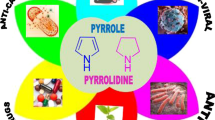Reductive intramolecular cyclization of N-(2-NO2-4-R-phenyl)pyridinium chlorides has been used to synthesize tricyclic condensed imidazole derivatives with a nodal nitrogen atom, pyrido[1,2-a]benzimidazoles. Ways of further modification of these compounds by means of nitration and reduction reactions are outlined. It is established that all obtained pyrido[1,2-a]benzimidazoles possess intercalation activity, i.e., are capable of producing undercondensation of chromosomes by inserting between pairs of DNA nitrogenous bases. The most active compound, 7-NH2-pyrido[1,2-a]benzimidazole, at a concentration of 1 mg/mL increases the length of L. grandiflorum chromosomes by 2.23 times compared with a control and provides a greater delay of condensation in experiments with 9-NH2-acridine.
Similar content being viewed by others
References
O. V. Muravenko and A. V. Zelenin, Genetika, 45(11), 1457 – 1471 (2009).
E. B. Skibo, I. Islam, A. J. Heileman, et al., J. Med. Chem., 37(1), 78 – 92 (1994).
I. S. Golubeva, I. Yu. Kubasova, N. P. Yarovskaya, et al., Khim.-farm. Zh., 34(7), 3 – 5 (2000).
S. K. Kotovskaya, Z. M. Baskakova, V. N. Charushin, et al., Khim.-farm. Zh., 39(11), 12 – 16 (2005).
O. Himanshu, M. M. Bhaskar, A. Sneh, et al., Chem. Pharm. Bull., 57(5), 481 – 486 (2009).
M. Hranjec, M. Kralj, I. Piantanida, et al., J. Med. Chem., 50, 5696 – 5711 (2007).
A. T. Karapetian, N. M. Mehrabian, G. A. Terzikian, et al., J. Biomol. Struct. Dyn., No. 14, 275 – 283 (1996).
A. V. Zelenin, “Acridine orange as a probe for cell and molecular biology,” in: Fluorescent and Luminescent Probes for Biological Activity, Academic Press, London (1999), pp. 117 – 135.
O. V. Muravenko, A. V. Amosova, T. E. Samatadze, et al., Cytometry, 51(1), 52 – 57 (2003).
I. V. Nosova, O. Yu. Semenova, T. E. Samatadze, et al., Biol. Membr., 22, 227 – 231 (2005).
O. V. Muravenko, V. A. Lemesh, T. E. Samatadze, et al., Genetika, 39(4), 510 – 518 (2003).
O. V. Muravenko, E. D. Badaeva, A. V. Amosova, et al., Genetika, 37(12), 1721 – 1724 (2001).
Acknowledgments
The work was supported by a grant from Carl Zeiss (No. YaRU 1/11 KTs).
Author information
Authors and Affiliations
Corresponding author
Additional information
Translated from Khimiko-Farmatsevticheskii Zhurnal, Vol. 45, No. 3, pp. 13 – 15, March, 2011.
Rights and permissions
About this article
Cite this article
Ryzvanovich, G.A., Begunov, R.S., Rachinskaya, O.A. et al. Synthesis and intercalation ability of new pyrido[1,2-a]benzimidazoles. Pharm Chem J 45, 141–143 (2011). https://doi.org/10.1007/s11094-011-0577-z
Received:
Published:
Issue Date:
DOI: https://doi.org/10.1007/s11094-011-0577-z




